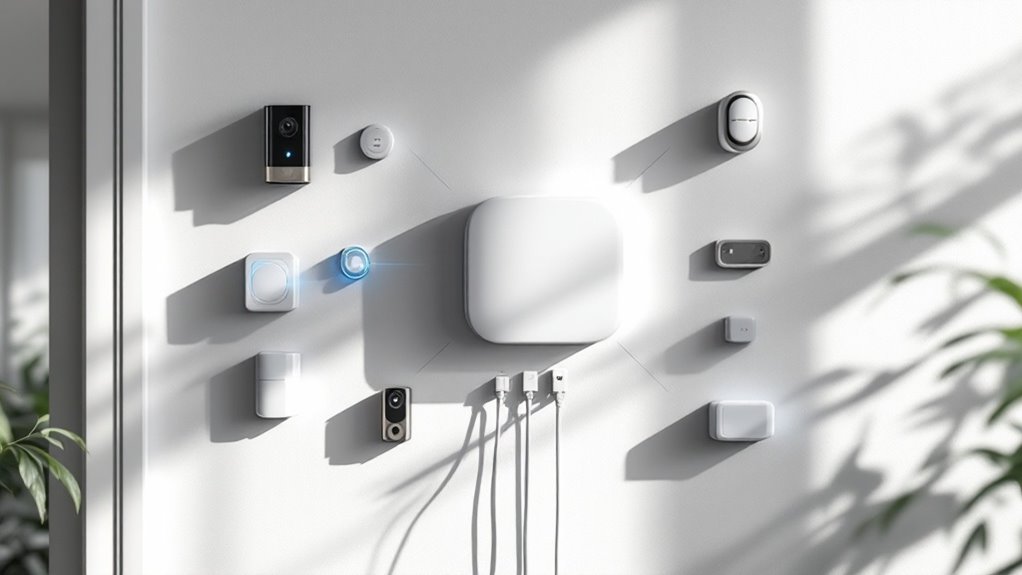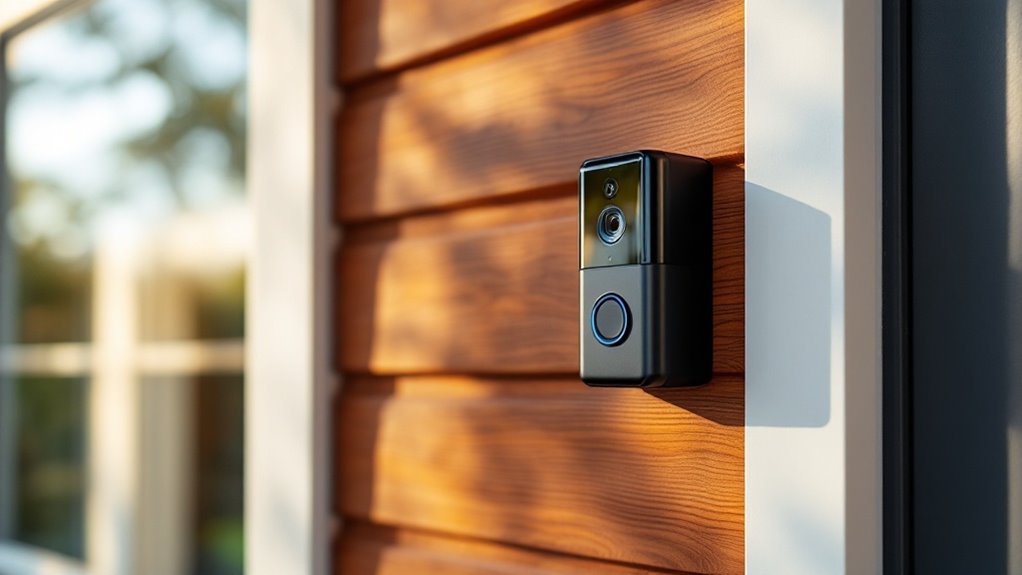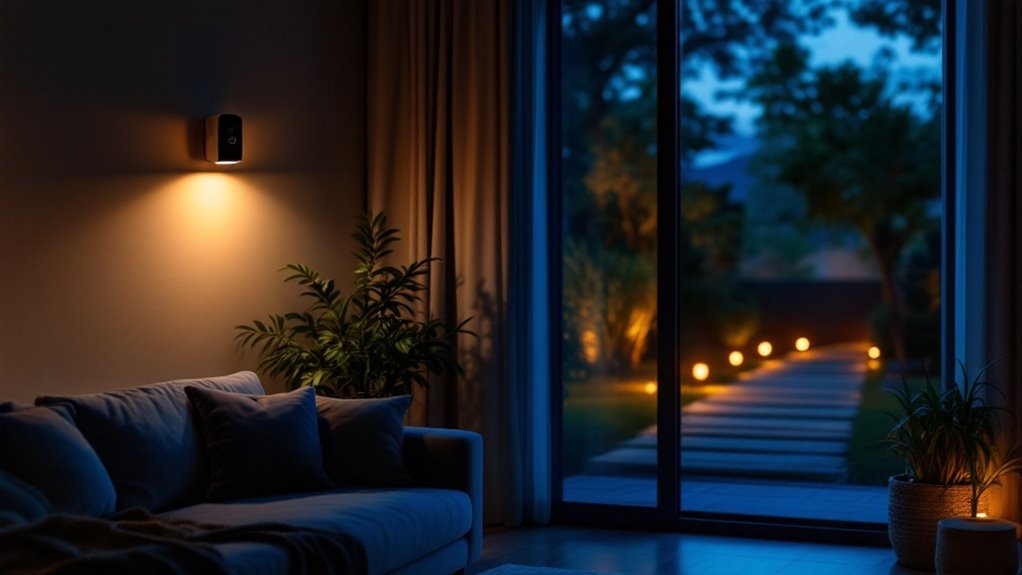You've probably noticed the rising costs of professional home security services, but you don't need to spend a fortune to protect your property effectively. Today's DIY smart security systems offer powerful features without monthly fees, giving you complete control over your home's safety. By selecting the right combination of cameras, sensors, and automation tools, you'll create an all-encompassing security network that keeps your family safe while keeping costs down.
Key Takeaways
- Select a compatible central hub like Home Assistant or SmartThings to integrate security devices without subscription requirements.
- Install Wi-Fi security cameras with local storage options through SD cards or network-attached storage to avoid cloud fees.
- Implement motion sensors near entry points and connect them with automated lighting systems for comprehensive perimeter protection.
- Choose battery-powered smart doorbells with local storage capabilities to eliminate both wiring costs and monthly subscription fees.
- Create automation rules linking sensors, cameras, and lights for a unified security system controlled through a free mobile app.
Understanding DIY Smart Security Components

When setting up your own smart security system, you'll need to understand the core components that work together to protect your home. The foundation starts with a central hub that connects your security devices through smart home protocols like Zigbee, Z-Wave, or Wi-Fi. This hub acts as your system's brain, coordinating all device communications.
A smart security system begins with a central hub, acting as the command center for all your connected safety devices.
Essential components include door and window sensors to detect breaches, motion detectors for movement tracking, and security cameras for visual monitoring.
You'll also want to take into account environmental sensors that alert you to smoke, carbon monoxide, or water leaks. Before purchasing any components, check device compatibility with your chosen hub to guarantee seamless integration.
Smart doorbells and automated locks can round out your security setup, giving you complete control from your smartphone.
Essential Wi-Fi Security Cameras and Features
Wi-Fi security cameras serve as the eyes of your smart home security system, offering real-time video monitoring and recording capabilities.
When selecting cameras, you'll want to focus on essential features that guarantee reliable surveillance of your property.
Look for cameras with at least 1080p camera resolution for clear footage and dependable night vision that can capture detail in low-light conditions. You'll also need weatherproof models for outdoor placement.
- Two-way audio for communicating with visitors or deterring intruders
- Motion detection with customizable zones to reduce false alerts
- Local storage options through SD cards or network-attached storage
- Mobile app integration for instant notifications and live viewing
Choose cameras that offer these core features without requiring subscription fees to maximize your investment in DIY home security.
Smart Doorbell Options and Installation Tips

Smart doorbells have revolutionized how homeowners monitor and interact with visitors at their front door.
You'll want to look for essential smart doorbell features like HD video, two-way audio, motion detection, and night vision. Consider models that offer local storage options to avoid subscription fees while maintaining your privacy and security.
Before installation, check your existing doorbell's voltage and wiring compatibility. You'll need a strong Wi-Fi signal at your entrance, and it's vital to mount the device at the right height – typically 48 inches from the ground.
If you're replacing a traditional doorbell, turn off the power at your breaker box first. For homes without existing doorbell wiring, choose battery-powered models that offer similar features without complex installation.
Motion Sensors and Alert Systems
Because motion sensors serve as your home's digital watchdogs, they're essential for an all-encompassing security system.
Motion sensors act as tireless guardians of your home, providing essential protection through constant digital surveillance.
You'll want to focus on proper sensor placement to maximize coverage while minimizing false alarms. Consider installing them in key areas where intruders might enter, and connect them to your smart alerts system for instant notifications.
Strategic sensor placement guarantees complete protection:
- Corner mounting at a height of 6-8 feet for peak coverage
- Positioning away from heating vents and direct sunlight to prevent false triggers
- Installing near entry points like windows and doors
- Placing sensors in high-traffic areas such as hallways and staircases
When your motion sensors detect movement, they'll instantly send smart alerts to your phone, letting you check on your property from anywhere.
You can even customize sensitivity settings to account for pets.
Automated Lighting for Enhanced Security

Automated lighting provides a powerful deterrent against potential intruders while making your home appear occupied even when you're away.
You'll want to set up automated schedules that randomly turn lights on and off throughout different rooms, mimicking natural human behavior. This unpredictable pattern keeps potential burglars guessing about your home's occupancy status.
Install light sensors near entry points to trigger instant illumination when movement is detected. You can connect these to both indoor and outdoor fixtures, creating a well-lit perimeter that eliminates hiding spots.
For added realism, program your smart lights to gradually brighten and dim at sunrise and sunset, just as you'd naturally adjust them. Consider linking your TV's smart plug to your lighting system, creating the convincing illusion of someone watching television in the evening.
Window and Door Sensors Worth Investing In
When protecting your home, reliable window and door sensors form the foundation of any thorough security system.
You'll want to evaluate various window sensor types, from basic magnetic contact sensors to more advanced glass break detectors. The key is strategic door sensor placement at every entry point – not just your main doors.
For maximum protection, you'll need:
- Surface-mounted magnetic sensors that alert you when windows or doors open
- Recessed sensors that hide inside door frames for a cleaner look
- Glass break sensors that detect the sound frequency of breaking glass
- Motion sensors that complement your window and door protection
Remember to test your sensors monthly and replace batteries annually.
Position them where they can't be easily tampered with, and always install them on the inside frame rather than the moving part.
Smart Locks and Access Control Methods
Modern smart locks have revolutionized home access control by replacing traditional keys with digital alternatives that you can manage remotely. You'll gain convenience and enhanced security through keyless entry options like PIN codes, smartphone apps, and biometric authentication methods.
Your smart lock can notify you whenever someone enters or exits, allowing you to track family members' arrivals and monitor service providers. You can create temporary access codes for guests or workers and revoke them instantly when no longer needed.
Many smart locks integrate seamlessly with video doorbells and security cameras, giving you a complete view of who's at your door and the ability to grant access from anywhere. For added security, look for models with built-in tamper alarms and automatic lock features that engage if you forget.
Video Storage Solutions and Cloud Alternatives
Smart security devices continuously capture footage, making reliable video storage a key consideration for your home system.
You'll need to choose between cloud storage options and local storage solutions based on your specific needs and budget.
While cloud storage provides convenient remote access and backup, local storage gives you complete control over your data without recurring fees.
You can mix both approaches for added security.
- Network Attached Storage (NAS) devices let you store weeks of footage locally without monthly costs
- MicroSD cards in cameras offer a simple solution for individual device storage
- External hard drives connected to your home network provide flexible capacity expansion
- Self-hosted solutions like Home Assistant allow you to create your own secure cloud storage system
Consider starting with local storage and gradually expanding your setup as needed.
Mobile Apps and Remote Monitoring Tools
Managing your home security system effectively requires three essential mobile tools: a primary control app, remote viewing software, and instant notification systems. Your primary app serves as your system's command center, letting you arm, disarm, and adjust settings from anywhere.
Remote viewing capabilities give you real-time access to your camera feeds, guaranteeing you can check on your property whenever needed.
Remote monitoring puts real-time camera surveillance in your pocket, so you can keep watch over your property from anywhere, anytime.
The mobile app features you'll want include customizable alerts, motion detection zones, and two-way audio communication.
Remote monitoring benefits extend beyond basic security – you can verify package deliveries, check on pets, or guarantee your kids arrived home safely.
Look for apps that offer user-friendly interfaces, quick response times, and the ability to share access with trusted family members or neighbors when you're away.
Integrating Your Security Devices Into One System
While individual security devices can function independently, creating a unified system delivers superior protection and convenience.
You'll want to tackle device compatibility challenges head-on by selecting components that work with your chosen centralized control solutions. Modern hubs like Home Assistant or SmartThings can bring your cameras, sensors, and alarms together seamlessly.
- Choose a primary automation platform that supports your existing devices
- Create automation rules to trigger multiple devices simultaneously
- Set up device groups to control related security components together
- Use IFTTT or similar services to bridge compatibility gaps between devices